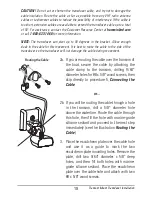
3. Continue to hold the bracket on the transom of
the boat, and use a pencil or marker to mark
where to drill the two mounting holes. Mark the
drill holes near the top of each slot, making sure
that your mark is centered in the slot (see the
illustration
Using the Mounting Bracket to
Mark the Initial Drill Holes
).
4. Make sure that the drill bit is perpendicular to the
actual surface of the transom, NOT parallel to the
ground, before you drill. Using a 5/32” bit, drill the
two holes only to a depth of approximately 1”.
NOTE:
On fiberglass hulls, it is best to use progressively larger drill bits to reduce
the chance of chipping or flaking the outer coating.
3. Assembling the Transducer and Initial Mounting
In this procedure, you will assemble the transducer using the hardware provided,
then mount it and make adjustments to its position without locking it in place.
NOTE:
You will initially assemble the transducer and the pivot arm by matching the
two ratchets to a numbered position on the transducer knuckle. Further adjustments
may be necessary.
1a. If you already know your transom angle, refer to the chart below for the
initial position to use to set the ratchets. If your transom is angled at 14
degrees (a common transom angle for many boats) use position 1 for the
ratchets. In either case, go to step 2. If you do not know your transom
angle, go to step 1b.
or...
NOTE:
The third hole should not be drilled until
the angle and height of the transducer is finalized,
which you will not do until a later procedure.
Using the Mounting Bracket
to Mark the Initial Drill Holes
Mark Initial
Drill Holes
4th hole
3rd hole
13
Transom Mount Transducer Installation































